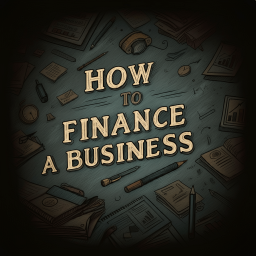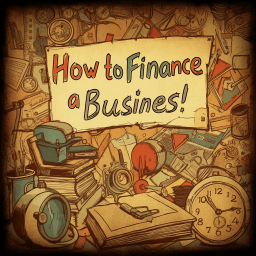Physical Address
304 North Cardinal St.
Dorchester Center, MA 02124
Physical Address
304 North Cardinal St.
Dorchester Center, MA 02124

This page is all about how to finance a business. Starting or growing a business is one of the most exciting challenges you can take on, but let’s face it—dreams alone won’t pay the bills. The journey of entrepreneurship requires not just passion and vision but also resources, and more often than not, that means securing capital. Whether you’re working on turning a bold new idea into reality, scaling your existing business to reach more customers, or simply trying to bridge a financial gap during tough times, understanding how to finance a small business is critical to your success.
The world of business financing can feel overwhelming at first, with a dizzying array of options, terms, and processes. Should you go for a traditional loan, seek out investors, or explore alternative methods? How do you figure out exactly how much you need, and what do you do if one lender says no? These are the kinds of questions that can keep any business owner up at night.
But here’s the good news: You’re not alone, and you’re not the first entrepreneur to face the challenges of how to finance a business venture. Thousands of business owners have stood exactly where you are now and successfully navigated their way to the funding they needed.
This guide is here to help you. We’ll break down the sometimes-intimidating world of how to finance a business into clear, actionable steps. You’ll learn:
By the end, you’ll not only understand your financing options but also feel confident in your ability to choose the strategy that best aligns with your goals. Whether you’re seeking a small loan to get your business off the ground or exploring alternative funding methods to seize a once-in-a-lifetime opportunity, this guide will equip you with the tools and knowledge you need to succeed.
The journey toward financing your small business begins with preparation, clarity, and determination—and you’re already taking the first step by reading this guide. Let’s start by looking at the first main step in how to finance a business:

Before considering various financing options for how to finance a business, take a step back and evaluate your “why.” Financing isn’t a one-size-fits-all solution, and understanding your purpose can guide you toward the option that best meets your needs.
Here are some common scenarios that prompt business owners to seek funding:
When trying to establish how to finance a business, you first need to calculate how much funding you need. Be specific. Knowing why you need financing is important, but equally critical is understanding how much you need. Here’s how to calculate it:
Being specific and detailed in your calculations when you are figuring out how to finance a business has two main benefits. Number one, it helps you avoid borrowing too much (and paying unnecessary interest), Number two, it also demonstrates professionalism when pitching to lenders or investors.
Want more actionable insights and expert advice? The Creator’s Wallet newsletter offers indispensable tips for creators and small business owners alike.
Now that you’ve clarified why you need financing and how much you require, it’s time to explore your options. Business financing generally falls into three categories: debt financing, equity financing, and alternative methods. Each has its advantages, drawbacks, and ideal use cases.
Debt financing involves borrowing money and repaying it over time, typically with interest. This is the most common form of business financing when figuring out how to finance a business and is often used by established businesses with steady cash flow.
Popular Debt Financing Options:
Pro Tip: Use debt strategically. Borrow to invest in high-return opportunities like marketing campaigns or equipment upgrades rather than plugging operational holes. This ensures the loan works to grow your business rather than just sustain it.
NinjaCFO
Equity financing involves raising money by selling a share of your business. It’s particularly common among startups and companies trying to figure out how to finance a business with high growth potential. It’s tempting, but it comes at a price. It usually involves sacrificing some control over your business.
Sources of Equity Financing:
Watch Out: Giving up equity means sharing decision-making power. If you decide that equity financing is an option when figuring out how to finance a business, pause and think. Make sure you fully understand the terms and implications before entering into an agreement.
If traditional debt or equity financing isn’t a fit when you’re trying to figure out how to finance a business, alternative options may suit your needs. These methods are often more accessible but can come with unique challenges.
Examples of Alternative Financing:
Alternative financing options can be particularly useful for newer businesses or those in niche industries that may not qualify for traditional loans.
By now you’ve seen that when it comes to how to finance a business, each financing method has its own pros and cons. What works for one business might not work for another. The key is to match the option to your unique needs, timeline, and goals.
]By understanding your options, you’re already ahead of the game.

Sometimes, the best way to understand how to finance a business and the impact of financing is through the lens of real-world examples. These success stories highlight how different approaches to financing helped businesses overcome challenges, seize opportunities, and thrive.
Figuring out how to finance a business and getting it established in the eco-friendly space can be challenging, especially when it comes to competing with established brands. One small cleaning product company faced this exact challenge but found an innovative solution: crowdfunding.
Using Kickstarter, they raised $50,000 to launch their sustainable product line, which included non-toxic cleaning solutions and reusable packaging. What made this campaign especially powerful was its dual purpose. Not only did it provide the funds necessary for production, but it also served as a marketing tool.
During the 30-day campaign, the company generated buzz on social media, attracting environmentally conscious consumers. By the time the products launched, they already had a loyal customer base eager to support the brand. Crowdfunding allowed them to avoid taking on debt, while simultaneously building brand awareness and customer loyalty.
Key Takeaway: Crowdfunding is more than just a funding tool—it’s a way to test the market, validate your idea, and build a community of supporters before your product hits the shelves.
NinjaCFO
A family-owned bakery had been thriving in their local community for years, but demand had outgrown their small storefront. To keep up, they needed to expand with a second location, but the costs of how to finance a business expansion with regards equipment, renovations, and staffing were overwhelming.
They turned to the Small Business Administration (SBA) and secured a $100,000 loan. While the application process required detailed financial projections and a robust business plan, the effort paid off. With the loan, they:
Within two years, their revenue had doubled, and the second location had become as popular as the first. The bakery also used the increased profits to pay off the loan ahead of schedule, leaving them in a strong financial position.
Key Takeaway: SBA loans can be an excellent option for businesses looking to expand, but success requires preparation. A strong business plan and financial projections can make all the difference in securing approval.
NinaCFO
A boutique retailer specializing in handmade jewelry hit a financial rough patch when supply chain issues caused delays in sales. With rent due and little cash flow, the owner approached her vendors and negotiated extended payment terms.
This arrangement allowed her to delay paying for materials until after the holiday season, when sales were expected to spike. By maintaining good relationships with her suppliers and communicating transparently about her situation, she avoided taking on debt or losing access to critical inventory.
When holiday sales surpassed expectations, she caught up on payments, replenished her inventory, and ended the year in a stronger position than before.
Key Takeaway: SBA loans can be an excellent option for businesses looking to expand, but success requires preparation. A strong business plan and financial projections can make all the difference in securing approval.
NinjaCFO
While figuring out how to finance a business, it becomes clear that financing is not a one-size-fits-all solution. Every method has its benefits and drawbacks, and understanding these trade-offs can help you make an informed decision.
| Financing Method | Pros | Cons |
| Bank Loans | Competitive rates, predictable terms | Strict requirements, long approval times |
| Angel Investors | No repayment, mentorship opportunities | Loss of equity and control |
| Crowdfunding | Market validation, brand exposure | Uncertain success, platform fees |
| Invoice Factoring | Immediate cash, no credit score needed | High fees, loss of invoice value |
Pro Tip: Evaluate not just the immediate benefits of each method, but also the long-term implications for your business’s financial health and independence.

Navigating the world of business financing can feel overwhelming, but the right tools and resources can make the process much smoother. Here are some practical resources to guide you in how to finance a business:
Keep an eye out for local resources, such as community development organizations or regional grant programs, which often provide funding and support tailored to small businesses in specific areas or industries. For example, attractive financing alternatives are sometimes made available to small businesses owned by women, veterans or ethnic minorities.

Understanding how to finance a small business is the first step toward turning your goals into reality. Whether you’re looking to launch a new venture, expand your operations, or weather an unexpected financial storm, the right financing strategy can make all the difference.
The key to success lies in preparation: know your needs, explore your options, and craft a compelling case for funding. By taking these steps, you can secure the resources you need to grow your business—and the confidence to make smart financial decisions.
Ready to stay ahead of the curve? Subscribe to The Creator’s Wallet for expert advice, inspiring success stories, and tools that make mastering your business finances easier than ever.
“The Creator’s Wallet” is your indispensable guide to mastering small business finances. Packed with actionable tips, expert insights, and the latest trends, it’s the go-to resource for creators and business owners alike. Subscribe today to take your financial knowledge to the next level!